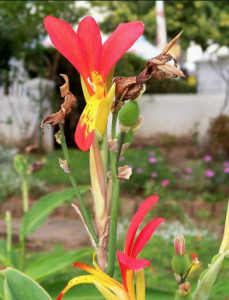A view from Whitianga, New Zealand

Now that the clocks have moved forward and the days are getting longer as we get closer to Spring, it’s time to start thinking about and planning the garden. Whether it’s to look at creating new flower beds or, perhaps a meadow addition, one of the easiest plants to grow and also one of the most beautiful is the lily.
Kincardine Times has heard from our readers in New Zealand, HappyDIYHome and they have recently provided an updated list of the many varieties of lilies, most of which will also grow in Ontario. We will take a look at some of those on the list of 24, but for the complete update, visit: Click Here
No matter which lily variety you choose, they work well in cottage, container, perennial, and cutting gardens. They can make a striking statement in woodland fringes and in naturalized meadows as well. They are flowering perennial bulbs that easily multiply once you establish them, and they create a garden or flower bed that is very easy to care for.
There are new hybrids available every year from breeders, and this improves the plants looks and performance while adding several vivid colors and different fragrances to the mix. There are almost 100 lily varieties available with hundreds of more hybrids, and this makes it easy to mix and match to create eye-catching displays.
Most lily varieties will bloom from the early summer months into the fall, and I’ve picked out several different types you can add to your landscaping. I’ll give you photographs of each lily variety so you know how to plan out your landscape design, and I’ll list each one’s perfect growing conditions to ensure you get big and beautiful blooms every year. You can use this lily variety list over and over and follow the guidelines whether you’re a novice or veteran gardener. Let’s dive in.
First on the list is the Lollipop.
Lollipop Lily

The first lily variety of the list is the Lollipop Lily. It grows best in zones three to eight, and it is an Asiatic hybrid lily that you won’t find growing naturally anywhere. Under the correct conditions, it can grow up to 36 inches tall, and it looks best when you plant it in masses of five, seven, or more plants. It needs well-drained but rich soil to thrive, and it likes to be in an area that offers full sun to partial shade. The soil should stay consistently moist without being saturated or drying out, and it’ll rapidly multiply from year to year. You get two-toned flowers with bright pink tips with white centers.
Regal Lily

This lily variety offers trumpet-shaped flowers that are white, and it’s very similar to what you see when you have Easter Lilies. However, this plant grows much taller, and you’ll have to provide adequate support to stop it from leaning. It can get between three and five feet high when you plant it in zones four to eight, and this lily is native to Southwestern China. It can produce two dozen flowers that are six inches long on each stem, and it starts to bloom during the summer months. Plant it in a well-draining but rich soil, and make sure that it’s in an area that gets partial shade to full sun for the best results. The more sun it gets, the better the plant will bloom through the summer.
Matrix Lily

As another hybrid lily variety, the Matrix Lily offers intensely colorful flowers that are very eye-catching when you plant them on your patio or in a highly visible spot in your backyard. On every stem, this flower can produce an impressive number of buds, up to seven. This is why you only need a few flowers to create a stunning focal point, and it starts blooming during the early summer months. It has petite stalks that make it an excellent choice for containers, and it gets between 16 and 20-inches tall. It grows best in zones four to eight, and you want to plant it somewhere that gets part shade or full sun. Water it regularly, and make sure that the soil doesn’t retain a lot of moisture.
Easter Lily
In early March, you’ll notice containers of while lilies appearing all over.
For many Christians, this lily variety symbolizes rebirth and purity, and it’s popular for Easter celebrations. This is a true lily species that is native to the United States, Taiwan, and southern Japan. It’s a parent species to several different trumpet lilies. They bloom in zones four to eight in July and August, and they can get between two and three feet high. They like partial shade to full sun, and the soil should be rich but well-draining. Make a point to keep the soil moist without saturating it to encourage them to come back year after year.
Christians, this lily variety symbolizes rebirth and purity, and it’s popular for Easter celebrations. This is a true lily species that is native to the United States, Taiwan, and southern Japan. It’s a parent species to several different trumpet lilies. They bloom in zones four to eight in July and August, and they can get between two and three feet high. They like partial shade to full sun, and the soil should be rich but well-draining. Make a point to keep the soil moist without saturating it to encourage them to come back year after year.
Casa Blanca Lily

If you have a white flower garden, you absolutely need to add this lily variety. This is an Oriental hybrid, and it has larger petals with a waxy look and feel that stand out when you put them in cut flower arrangements. It’s very popular in bridal flower arrangements. They have long stems, and they bloom during the mid and late summer months. This is a highly fragrant flower that grows best in zones five to eight. You will have to shelter it from high winds to stop it from snapping, and it can get between three and four feet high. Plant it in an area with partial shade to full sun, and make sure the soil drains well between watering sessions.
Canna Lily
The final lily variety of the list is the Canna Lily. They’re very easy to grow and keep alive if

you live in zones 7 to 11, and these are actually false lilies that are more closely related to the Bird of Paradise flower than they are to actual lilies. However, they produce lily-like flowers in a range of colors with speckles. They need well-draining soil that is slightly acidic, and they need regular watering sessions to keep them happy. Plant them in a place that gets full sun to partial shade, and they can do well in boggy or slightly wet conditions. They’ll help attract pollinators to your yard like hummingbirds and butterflies, and they release a sweet scent when they bloom that is very pleasant.
Enjoy your lilies in the garden but avoid bringing them inside if you have a cat. The one drawback is that they are extremely poisonous should your cat lick them or even touch them and then lick their paws.
In the meantime, enjoy these beautiful pollinators in your garden and for the complete list, CLICK HERE.










